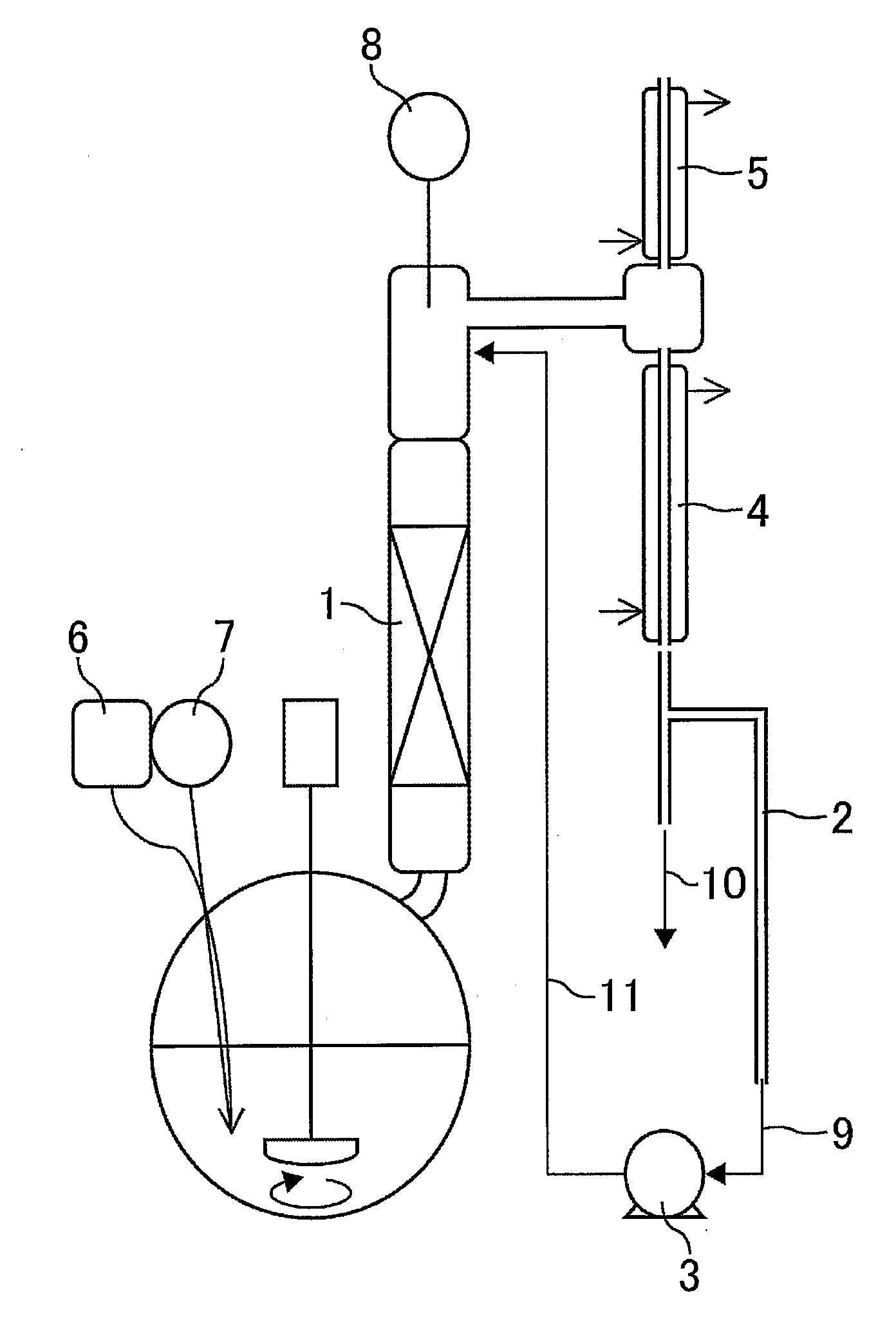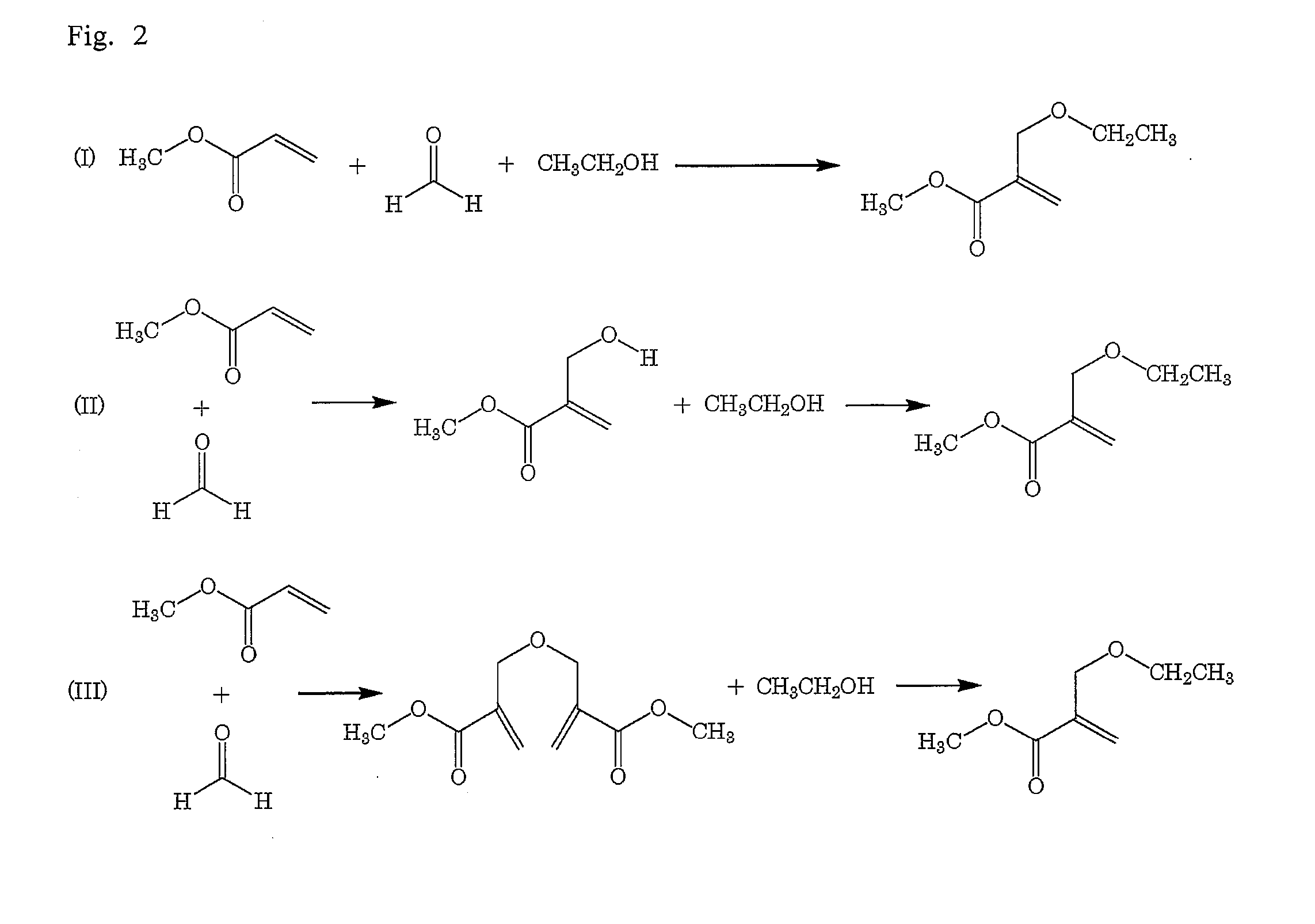Alpha-substituted acrylate esters, composition containing thereof, and method for producing those
a technology of acrylate esters and acrylate esters, which is applied in the preparation of carboxylic acid esters, chemistry apparatus and processes, and organic chemistry, etc. it can solve the problems of waste detoxification, equipment corrosion, waste disposal, etc., and achieves easy reaction, high yield, and the effect of allowing the reaction to take a shorter tim
- Summary
- Abstract
- Description
- Claims
- Application Information
AI Technical Summary
Benefits of technology
Problems solved by technology
Method used
Image
Examples
examples 1 to 25
[0143]The reactions and analyses were carried out in the same manner as Comparative Example 1 except that the catalysts shown in Table 1 were used. The results are shown in Table 1. In Table 1, values of the amount used of the tertiary amine, the amount used of the acid, the material conversion rate and the yield are represented as molar ratio relative to 100 mol % of methyl α-hydroxymethylacrylate. With regard to the tertiary amine and acid, the values in brackets represent the amounts used. Abbreviations in Table 1 represent the followings.
DABCO: Triethylenediamine
TMA: Trimethylamine
[0144]AcOH: Acetic acid
PhCO2H: Benzoic acid
(CO2H)2: Oxalic acid
TCP: 2,4,6-Trichlorophenol
MQ: Paramethoxyphenol
[0145]TolSO2H: p-Toluenesulfinic acid
B(OH)3: Boric acid
Zn(OAc)2: Zinc acetate
Zn(acac)2: Zinc acetylacetonate
Zn(OTf)2: Zinc triflate
Mg(OAc)2: Magnesium acetate
La(OAc)3: Lanthanum acetate
Al(OTf)3: Aluminum triflate
TMAHCl: Trimethylamine hydrochloride
HClaq., TEA: Mixture of hydrochloric acid and t...
example 26
[0146]To a round-bottom flask (500 ml), 203.2 g of methyl α-hydroxymethylacrylate, 9.8 g (0.1 equivalents) of triethylenediamine (DABCO) as the catalyst tertiary amine, 10.9 g of boric acid as the acid, 0.1 g of hydroquinone monomethyl ether as the polymerization inhibitor and 0.1 g of 4-hydroxy-2,2,6,6-tetramethylpiperidine-1-oxyl were added. The reaction solution was heated to 100° C. while blowing nitrogen containing 7% oxygen at 5 ml per minute. After reduction of pressure to 10 kPa, the reaction was carried out for 2 hours while distilling produced water off. After recovering normal pressure, analyses of the reaction solution according to the above methods revealed that the conversion rate of methyl α-hydroxymethylacrylate was 89 mol % and the yield of the ether dimer relative to methyl α-hydroxymethylacrylate was 81 mol %. Then, a mixed solution of 9.8 g of triethylenediamine (DABCO) and 152.5 g (1.5 equivalents) of allylalcohol was fallen in drop to the reaction solution at 1...
example 27
[0148]To a round-bottom flask (500 ml), 203.2 g of methyl α-hydroxymethylacrylate, 152.5 g of allylalcohol, 9.8 g (0.05 equivalents) of triethylenediamine (DABCO) as the catalyst tertiary amine, 10.6 g (0.1 equivalents) of acetic acid as the Broensted acid, 0.1 g of hydroquinone monomethyl ether as the polymerization inhibitor and 0.1 g of 4-hydroxy-2,2,6,6-tetramethylpiperidine-1-oxyl were added. The reaction solution was heated to 100° C. while blowing nitrogen containing 7% oxygen at 5 ml per minute. The conversion rate of methyl α-hydroxymethylacrylate, the yield of methyl α-allyloxymethylacrylate relative to methyl α-hydroxymethylacrylate, the selectivity of methyl α-allyloxymethylacrylate, the yield of methyl α-methoxymethylacrylate and the residual rate of DABCO are shown in Table 2. The thus obtained reaction solution was washed with water and distilled to give methyl α-allyloxymethylacrylate containing 0.05 wt % of methyl α-methoxymethylacrylate.
PUM
| Property | Measurement | Unit |
|---|---|---|
| pKa | aaaaa | aaaaa |
| mol % | aaaaa | aaaaa |
| mol % | aaaaa | aaaaa |
Abstract
Description
Claims
Application Information
 Login to View More
Login to View More - R&D
- Intellectual Property
- Life Sciences
- Materials
- Tech Scout
- Unparalleled Data Quality
- Higher Quality Content
- 60% Fewer Hallucinations
Browse by: Latest US Patents, China's latest patents, Technical Efficacy Thesaurus, Application Domain, Technology Topic, Popular Technical Reports.
© 2025 PatSnap. All rights reserved.Legal|Privacy policy|Modern Slavery Act Transparency Statement|Sitemap|About US| Contact US: help@patsnap.com



